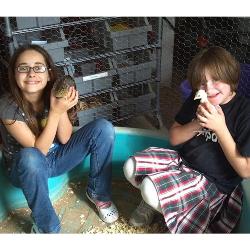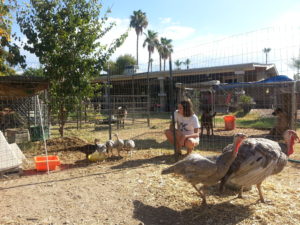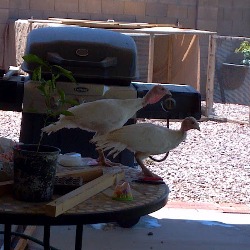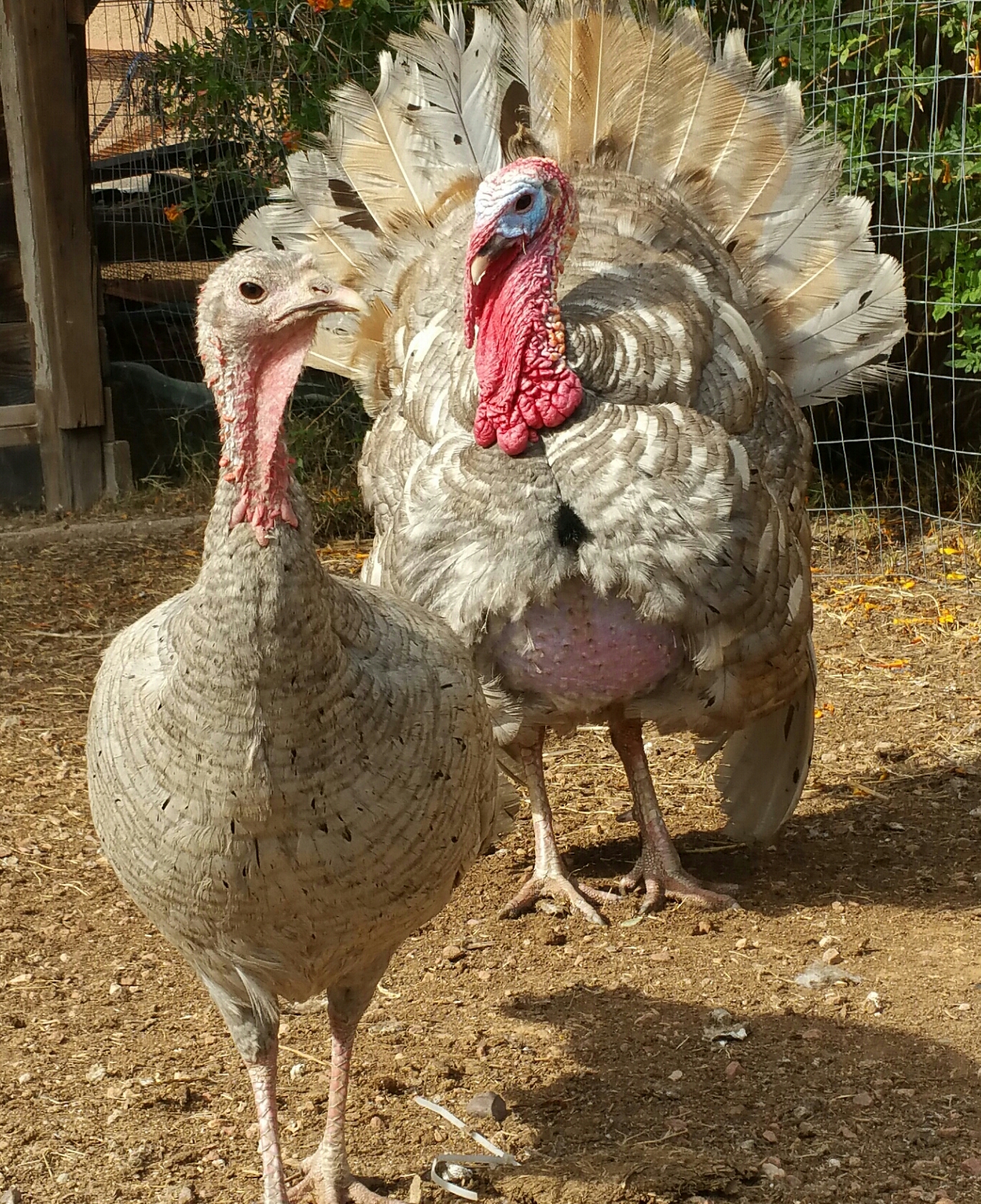Raise a Heritage Turkey in Honor of National Turkey Lovers’ Month…or for Thanksgiving & Christmas, of Course!
Each June, we celebrate National Turkey Lovers Month on the farm as we prepare for the summer and the upcoming hatching of our hen’s eggs. I proudly say that I am one (a heritage turkey lover, that is!)
When talking turkey, Thanksgiving day springs to the mind of most of us in the U.S. I love the holiday and the wonderful, roasted bird. But there is so much more to love about turkeys. There are many interesting breeds. Varietes range from the sleek wild birds that can fly to the domesticated Broad Breasted White (BBW) that is the most common commercially bred turkey. Some of them have gorgeous brightly colored feathers in all sorts of colors, including blues and greens that rival the peacock. This photo is an Ocellated turkey, native to the forests of the Yucatan Peninsula of Mexico (photo credit: National Geographic.)
Though they are not know for their brain-power, domesticated turkeys are friendly and entertaining to watch. Raised on a farm, or even in your backyard, they perform many of the same functions as chickens, laying eggs, eating bugs in the garden, and providing waste that is high in nitrogen for the compost pile.
In honor of Turkey Lovers’ Month, let’s take a closer look at this fascinating bird and how you, too, can raise your own.
The Heritage Turkey in United States History
The turkey has played an important role in U.S. history. Even prior to nationhood, eastern Native American tribes depended on the turkey for eggs and meat, which they dried to make a form of jerky that lasted them through the harsh winters. Their feathers were used for headgear and clothing. Paintings of the first Thanksgiving celebrated in 1621 often portray a roasted turkey among the items served, which may very well have been true as it was a staple of both the Wampanoag tribe and the pilgrims. The only eyewitness account, a letter written by colonist John Winslow to a friend in England, mentions “wildfowl” in his description of the meal.
Benjamin Franklin Preferred Turkeys to Balk Eagles
After the Great Seal of the United States was adopted by Congress on June 20, 1782 – featuring the bald eagle – Benjamin Franklin wrote a letter to his daughter, sharing his displeasure at the choice of symbols and his opinion that the eagle looked more like a turkey. Franklin wrote (excerpt,) “I am on this account not displeased that the Figure is not known as a Bald Eagle, but looks more like a Turkey. For the Truth the Turkey is in Comparison a much more respectable Bird, and withal a true original Native of America… He is besides, though a little vain & silly, a Bird of Courage, and would not hesitate to attack a Grenadier of the British Guards who should presume to invade his Farmyard with a red Coat on.”
Presidential Turkey Pardon
Though several presidents prior have reportedly spared the turkey that is presented to them by the National Turkey Federation each Thanksgiving, in 1989 President Bush formalized the tradition by granting his turkey a “presidential pardon.” Pardoned turkeys live out their natural lives on farms or at petting zoos, and some have even made their home at a Disneyland ranch. In 2005 and 2006, the turkeys served as Grand Marshals for the annual Disneyland Thanksgiving Day parade.
National Turkey Lovers’ Month
Nebraska Governor Dave Heineman proclaimed June “National Turkey Lovers’ Month” in a luncheon sponsored by the Poultry an Egg Division of the Nebraska Department of Agriculture at the governor’s residence in 2005.
Celebrate Turkey Lovers’ Month by trying a new turkey recipe from the National Turkey Federation’s website, which includes 1,100 turkey recipes. Search for the perfect recipe for you by specifying dish type, occasion, ethnicity, meal preference, ease of preparation and product type as well as sorting recipes that are low in fat, carbs, calories, cholesterol or sodium. Enjoy!
A Different Turkey on the Table
Nearly all of the turkeys sold for Thanksgiving in U.S. grocery stores are the Broad-breasted White industrial breed, also known as BBWs, which grow quickly and have a very large breast. Their ancestors are the heritage breeds, including the Standard Bronze, Bourbon Red, Narragansett, Jersey Buff, Slate, Black Spanish, White Holland, Royal Palm, White Midget and Beltsville Small White. These breeds are known for their gorgeous plumage and delicious flavor. Thanks to farmers and growers who are interested in preserving these breeds, they are beginning to make a comeback. Consumers, as well, are becoming aware of these breeds and a market for them is emerging, especially for free-range birds that are naturally and humanely raised.

On our farm, we have grown Broad-Breasted Whites (BBW) and Standard Bronze turkeys. The BBWs are unable to reproduce naturally, so a self-sustaining flock is impossible without human intervention. Many small farms and families choose to raise heritage breeds, some of which are slaughtered for food, and others that are bred to perpetuate the flock.
Where to Purchase Heritage Turkey for the Holidays
To purchase heritage turkey for Thanksgiving dinner, search online for heritage breeders and growers. Many of them begin to take orders during the summer, and will ship them to you or have them available for pick-up near Thanksgiving. Natural grocery stores may have them in stock or take orders for them, as well.
The following are a few sources for purchasing dressed heritage turkey:
If you are interested in raising your own heritage turkey, the following are a few breeders who will ship poults (baby turkeys):
Porter’s Rare Heritage Turkeys
How to Deep Fry a Turkey
While I generally feed my family very healthfully and avoid fried foods, the Thanksgiving Day meal is an exception. On that day, gravy, pies, and white dinner rolls with excessive butter are not only allowed, but encouraged! The turkey is generally the most healthful item on the menu, but they often turn out dry and tasteless in the oven. One of the best turkeys that I ever ate was fried instead of roasted. The skin was crisp and delicious and the meat was tender, juicy and full of flavor. It is very easy to fry a turkey, but follow the directions carefully to avoid burnt turkey or dangerous accidents with the hot oil. Here is how to fry a turkey to perfection:
Equipment
40- or 60-quart pot with basket and burner
Propane gas tank
Candy thermometer to measure oil temperature
Meat thermometer to determine when the turkey is fully cooked
For added safety, have a fire extinguisher and pot holders ready.
Location
Place fryer on a level area of dirt or grassy lawn, away from structures, kids and pets. Never fry a turkey indoors, in a shed or garage, or under any awning. Avoid frying on flammable surfaces, such as wooden decks or debris-covered ground. It is okay to fry on concrete, but keep in mind that the oil can stain.
Ingredients
Smaller turkeys (8 to 10 pounds) or individual breasts, wings and thighs are best for frying. For a large bird, remove the legs and fry them separately first.
You’ll need approximately 5 gallons of cooking oil, but if your turkey is large, it may require additional oil. Turkey can be injected with a marinade, coated with breading or seasoned with a spice rub prior to cooking. If you use an water-based injection marinade, be certain to inject it deep into the meat and not just under the skin where it will cause the oil to sizzle and pop. Note: do not stuff turkeys to be cooked in the fryer.
Cooking Preparation
Before breading or marinating the turkey, determine the correct amount of oil to use and being heating it up. If your fryer does not have a “fill line indicator,” place the thawed turkey in the basket and lower it into the pot. Pour enough water into the pot to cover the turkey by 2 inches. Remove the turkey and measure the distance from the top of the pot to the surface of the water with a ruler. This is the depth to which you will fill the pot with oil. Discard the water and thoroughly dry the pot (and the spigot, it your fryer has one.) Fill with oil to the measured depth.
Heat the oil to 350 degrees F. Depending on the amount of oil used, this generally takes approximately an hour.
Frying the Turkey
Once the oil is heated, pat the exterior of the turkey dry and place it in the basket. Slowly lower it into the pot. For safety reasons, it is recommended to have two people working together to lower and raise the turkey.
Whole turkeys require approximately 3 minutes per pound to cook, so an 8 pound turkey would take approximately 24 minutes in the fryer. At the end of the calculated cooking time, remove the turkey from the fryer and check the internal temperature with a meat thermometer. The temperature should reach at least 170 degrees F in the breast and 180 degrees F in the thigh.
Additional Safety Tips
Carefully follow all of the manufacturer’s instructions for operating your fryer.
Never leave the hot oil unattended.
Don’t allow children or pets near the cooking area.
Immediately wash hands, utensils, equipment and surfaces that have come in contact with raw turkey to avoid bacterial contamination.
Allow the oil to cool completely before disposing of it or storing it for future use.
Turkey should be consumed immediately and leftovers covered and refrigerated within 2 hours of cooking.
This is the turkey fryer that I use.
Thermometers for Frying
When frying poultry, two types of thermometers are necessary. Use a candy thermometer or deep fry thermometer to monitor the heat of your oil, and a meat thermometer to measure the temperature of your turkey.
Raise Your Own Thanksgiving Heritage Turkey
It is fitting that June is National Turkey Lover’s Month as this is the time to begin raising your own heritage turkey for the Thanksgiving table. Turkeys raised from scratch require 4-6 months from hatch to “dispatch.” They are very easy and fun to raise, and they taste delicious! Purchased from a grower, free range and heritage turkeys cost in the $100 range (some are up to $200,) but you can raise them at home for much less. Additionally, they are wonderful to have in the yard during the summer months as their droppings are a natural fertilizer and they provide mowing services by eating the grass. As I write this article on my back patio, the turkeys and chickens are doing my yard work for me!
Turkey Raising Basics
Young turkeys can be obtained from farms and feed stores in the spring and early summer. If you prefer to raise your animals organically, buy your chicks from a source that does not vaccinate their animals routinely and that uses organic sources of feed. If you are not sure whether or not the chicks have been vaccinated or fed only organic feed, you can raise them naturally and/or organically from the moment that they are in your possession.
 Turkey Brooders
Turkey Brooders
We raise our ‘turkey babies” in a brooder made out of a plastic kiddie pool, placing a chicken wire fence around the outside when they are big enough to escape. For the first few weeks of life, they need a heat lamp with a red bulb to help them stay warm as they don’t regulate their own body temperature. They are fed wild game starter feed or turkey starter feed from a jar or trough feeder.
For young turkeys, water can be a danger, so a watering container with a thin trough is necessary to keep them from getting into the water and drowning (see some examples of watering containers below.) Turkeys are not too bright and will eat wood shavings instead of their feed, so I use beach towels for bedding until they are old enough to recognize the difference between bedding and food.
Kids and Turkeys
Children love baby animals. My own kids do most of the work in raising our chicks and poults simply because they enjoy them so much. If your children will be involved in the process, teach them to handle the tiny birds carefully and help them to understand in advance that they turkeys will become dinner at some point. We told our children not to name the turkeys in order to help them remain unattached, but they insisted, naming them after villains in literature and history. One of our current turkeys is named “Sammy,” which is short for sandwich.
Deciphering Turkey Gender
When you purchase young birds, you will not know if they are male or female. However, it will become apparent within a few weeks. It is hilarious to watch a 5-inch tall male turkey puffing up his feathers and tail and strutting around he brooder like he is big stuff! Soon the males become much larger in size than the females and develop a pronounced red crop.
Brooder Basics
Heat Lamps
Turkey poults need a heat lamp that will keep their brooder at 95 degrees for their first week of life, decreasing by 5 degrees each week until they are 5 or 6 weeks old. Adjust the temperature of the brooder by raising and lower the lamp. If turkeys are too cold, they will huddle together under the lamp. If they are too hot, they will stay as far away from the lamp as they can get. Adjust the temperature of your brooder accordingly.
A red bulb seems to be more soothing to the birds than a white bulb.
Feeders
You will need a small starter feeder that keeps food clean and has several points of access so that all your birds are able to eat without being blocked by a more aggressive bird.
Waterers
Clean, fresh, cool water is a must for little poults. Choose one that will allow several birds to drink at once. A jug with a dish is preferable to providing water in a bowl because they prevent little birds from immersing themselves in the water. Wet poults can die quickly, so keep them dry with a specialty watering device.
From Poults to Adults
At about 5 weeks of age, turkeys are ready to transition to an outdoor pen. Provide at least 8 square feed of floor space in your pen, a feeder, two water sources (just in case one gets contaminated or spilled,) and straw bedding. We keep our turkeys in the pen at night and when we are away from home. The birds wander the yard freely when we are home and keeping an eye on them. Young poults (turkey chicks) eat starter feed until they are 8 weeks old, at which time we switch to grower feed. They also eat bugs and plants in the yard, which is why their meat tastes different from (and better than) that of a store-bought turkey.
Training Pens
Our baby turkeys looked so small when we moved them into their outdoor pen, and they were happy to have lots of elbow room. But, soon, they began to outgrow it! In the photo to the left, adult turkeys are in the front of the view, and the poults are behind in a separate pen. Our males, who were once tiny and sweet, began to fight viciously, and had to be separated.
baby turkeys looked so small when we moved them into their outdoor pen, and they were happy to have lots of elbow room. But, soon, they began to outgrow it! In the photo to the left, adult turkeys are in the front of the view, and the poults are behind in a separate pen. Our males, who were once tiny and sweet, began to fight viciously, and had to be separated.
Their strong, clumsy bodies constantly knocked over their watering jugs and food trough, which we replaced with larger, sturdier models. Low bars were added with plenty of room for all to roost at night. We did not give them high bars because we were concerned that as they grew heavy, they may risk harming their legs when jumping down from them.
Flying
Although our first turkeys were heavy, broad-breasted breeds, that did not stop them from flying. Every morning when we opened the door to their pen, they would run out full speed and take off like airplanes on a runway. Occasionally, one would clear the fence or find herself on the roof and unsure how to get back down. Fortunately, they were too large to fly far. And since they were becoming large and strong, we decided that it was not worth attempting to clip their wings.
Turkey Disposition
Turkeys are qui te friendly, and they tend to want to be near people. While our chickens prefer to wander the yard and don’t seem very interested in hanging out with us humans, the turkeys’ favorite place to perch is on patio furniture. When the family is outside, they are always very curious about what we are doing. The photo to the left is of two young turkeys “assisting” in a project on which we were working on the patio.
te friendly, and they tend to want to be near people. While our chickens prefer to wander the yard and don’t seem very interested in hanging out with us humans, the turkeys’ favorite place to perch is on patio furniture. When the family is outside, they are always very curious about what we are doing. The photo to the left is of two young turkeys “assisting” in a project on which we were working on the patio.
Turkey Behaviors
During the last month of their lives, the turkeys are reaching full size and their large feet and heavy bodies become detrimental to my gardens. What they don’t eat, they trample. A quick spray with the water hose will deter our chickens from getting into garden areas in which they are not welcome, but even a hard spray will not deter a turkey. This is true when males fight, as well. Once they begin a row, it is nearly impossible to distract them and they must be separated. For these reasons, they spend more time penned up as as they mature. After their daily wander in the yard, they are easily herded as a group with a broom back into their pens.
Turkey Sanitation
Turkeys are similar to chickens in many ways, but there are some distinct differences, as well. Unlike chicken coops that have little unpleasant odor when kept clean, turkeys stink. This may have to do partially with their size, which means larger amounts of fecal matter. The problem is compounded by the fact that turkeys do not scratch like chickens. Chicken waste dries out quickly as the chickens scratch through it and throw it around in their search for bugs and grit in the soil. Turkeys, on the other hand, trample their waste and it quickly becomes matted on the bottom of the pen. Regular, if not daily, cleaning is necessary for turkeys that do not free-range full time.
Additionally, turkeys are wasteful of food. Unlike chickens that scratch the ground looking for tiny scraps, turkeys do not eat spilled food. A galvanized metal hanging feeder can help to cut down on feed waste.
Free Range Turkeys & Mixed Flocks
We allowed our turkeys and chickens to free-range together, but the chicken coop and the turkey pens were on opposite ends of the property. We were not too concerned about diseases being passed back and forth between the two flocks since our numbers were small, but we kept their quarters separate to be on the safe side. Additionally, we did not want our chickens eating the turkey’s high protein game bird feed due to concerns that it might damage their kidneys. And while they lived together in peace most of the time, we did not want a fight to break out between the flocks while we were not supervising.
Pen Maintenance
Regular cleaning kept our pens reasonably sanitary and the smell tolerable. Old straw and spilled food would be raked out of the pen and added to the compost piles, and new straw spread on the floor. Water jars would be rinsed and left in the sun to dry while the birds were free-ranging. The hot Arizona sun served as the disinfectant, essentially “cooking” the germs to death.
Turkey Disappointment
After eating pounds and pounds of food and growing to an enormous size, our largest turkey died suddenly for unknown causes, perhaps the heat, a fight or a scorpion sting. There were no clues as to the cause of death, and our disappointment was great. When a bird dies on our farm, we bury it around the base of a tree or in one of the flower gardens. We avoid burying them near food, however, to prevent contamination of our veggies.
A very large hole was dug in an ornamental garden and the turkey was placed in it with a generous sprinkling of hydrated lime to aid the decomposition process. Dirt was returned to the hole and a large paver was installed to deter the dog from getting any ideas about digging. Though we were sad that we would not be able to eat the enormous turkey for Thanksgiving dinner, loss is an inevitable part of raising animals and we have learned to chalk it up to free fertilizer and organic matter for our hard, mineral soil.
Processing
All summer long, the turkeys wander the yard and gardens, eating grass, weeds and bugs in addition to their feed, and getting larger and larger! I often see them wandering the herb garden, and I wonder if they are pre-seasoning themselves for Thanksgiving. By their 18th week, we decrease the amount of time that they have to wander the yard, eating whatever they please, in order to cut down on “gamey” flavor in the meat. For a few weeks, they are given corn in addition to their regular feed to help them put on weight for the inevitable.
Kids and Processing Day
No matter how much we enjoy them wandering the yard, at some point the turkeys must be “processed” and sent to camp deep-freeze. By 4-6 months of age, the females will be 15-25 pounds and the males upwards to 40 pounds each. We barter one of the turkeys to a friend who helps us to slaughter and butcher the turkeys. Our children help, to varying degrees, according to their individual tolerances for viewing and handling turkey parts and pieces and how attached they have grown to the animals. Two of our kids vacate the premises, and the other two are fascinated by the process and by learning about turkey anatomy that is generally hidden from view. We do not force our children to participate, but gladly allow them to do so.
Post-Processing
Although processing day is the least pleasant part of the process, it only lasts a few hours, and then we have delicious, fresh turkey for the holidays. Supplies and pens are cleaned and put away for the winter and the ground that was under the turkey pen becomes a winter garden. The yard is quiet until next spring when a new batch of poults will make their brief home with us.
That’s me holding up a large turkey breast, the reward for our labor. Once the turkeys are gutted or butchered, they are placed in cold salt water for several hours and then wrapped and frozen. It is very satisfying to have a shelf in the freezer that is stocked with home-grown meat. I have to admit, however, that it will be a few weeks before I will be able to bring myself to thaw, cook and eat any of it.
cold salt water for several hours and then wrapped and frozen. It is very satisfying to have a shelf in the freezer that is stocked with home-grown meat. I have to admit, however, that it will be a few weeks before I will be able to bring myself to thaw, cook and eat any of it.
This year, we slaughtered in September in order to provide some distance between “processing day” and Thanksgiving. After going through this process, I definitely look at meat in the grocery store differently, with a great awareness of the preciousness of food, particularly from animal sources, and how valuable it would become if our constant, abundant supply suddenly disappeared. I am also empowered to know that if worse came to worse, we would be able to feed our family quality protein from our own farm.
Support Farms that Raise Heritage Turkey
Though you may not celebrate National Turkey Lovers’ Month by bringing home turkey poults, I hope that you enjoyed reading about this fascinating bird and our turkey-rearing adventures. If raising turkeys isn’t for you, consider supporting farmers who raise heritage breeds by purchasing a natural turkey from your local grower. Get your order in early. The popularity of naturally raised turkeys is on the rise, and growers often sell out long before November. Happy eating!
Learn More about Heritage Turkey, Homesteading and Urban Farming
- The Backyard Farming Connection: Raising Turkeys
Visit this page to learn more about turkeys, or to post your own turkey info.


